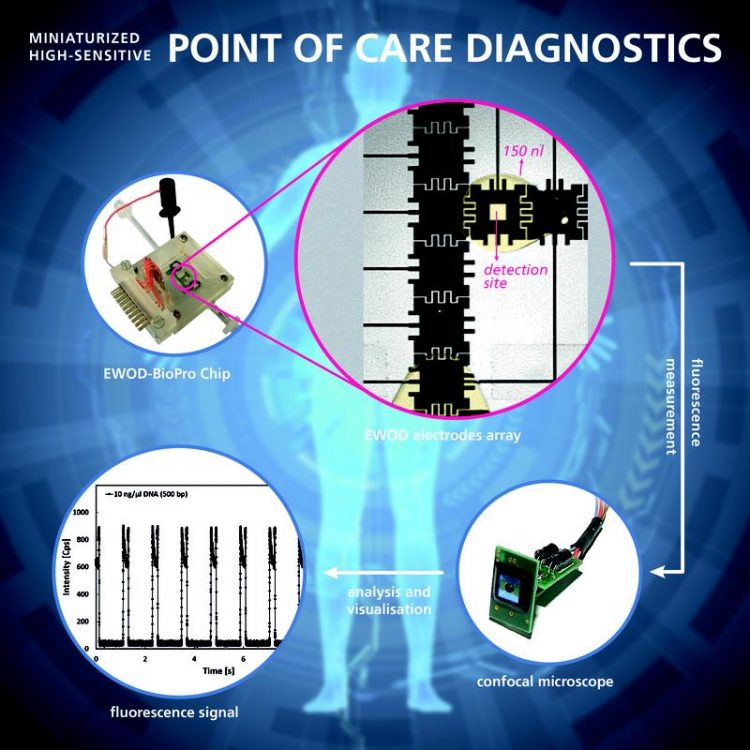Fraunhofer FIT at MEDICA and COMPAMED: Electrowetting and Telemedicine

The EWOD-BioPro Electrowetting-On-Dielectric system can help to better understand biological mechanisms and interactions. © Fraunhofer FIT
An important aspect of pharmacology is to understand how active drug ingredients cross-react with endogenous molecules. But until now, such reactions could only be determined after the event. The precise details of the interacting factors remained unclear.
Researchers at Fraunhofer FIT have developed a system that now allows monitoring biochemical reactions at the single-molecule level from start to finish. It is based on the physical effect of Electrowetting-On-Dielectric (EWOD), widely used in micro-fluidics.
Our EWOD-BioPro system is capable of merging reagent droplets as small as 150nl with very high precision. This allows us to monitor the reaction process using a confocal microscope adapted at FIT, and to record high-resolution measurements.
“For the first time we can observe the details of how the two droplets interact at the single-molecule level – thus allowing us to monitor the entire chain of events,” says Lorenz Sparrenberg from the Fraunhofer Institute for Applied Information Technology FIT, who is leading the research project.
Thus, we can study biological interactions under conditions closely resembling those that occur naturally in the human body. In pharmacology, for example, it is important to understand the effects of drug ingredients as precisely as possible and know when these effects occur.
But the combination of EWOD and confocal microscopy may also be used to study the interaction between complementary DNA strands, antibodies and antigens, or enzyme-substrate reactions.
Conventional laboratory tests not only deliver less information but also require much higher quantities of the sample liquids, and take longer to perform. The typical duration of an enzymatic assay, for example, is around 15 – 20 minutes. The EWOD-BioPro system can present the results within 30 seconds. It may thus be a further step
towards point-of-care diagnostics, where test are carried out at the bedside in hospitals or in the physician's office instead of sending samples to a central laboratory.
The EWOD-BioPro system will be presented at COMPAMED, in Düsseldorf, 12 – 15 November 2018, hall 8a, booth P13.
>>teliFIT – Intelligent platform for telemedicine and telecoaching
The teliFIT platform features a modular, expandable architecture. It can accommodate a multitude of user groups with their specific access rights and can easily be tailored to a wide range of design requirements, contents and functions. The platform's current functionalities may be grouped in five categories: Communication, Monitoring, Analysis, Smart Data Services and Safety & Security. Individual functions can be activated or extended as required.
Smart devices can be used to capture and upload data to the teliFIT platform. Processing results are presented in visually attractive charts, but also offer relevant context. For example, teliFIT offers a nutrition diary that automatically evaluates the calories taken in against the user's individual basic requirement. Actual intake is also evaluated in relation to agreed nutritional goals.
Data security has been a major design criterion for the teliFIT platform. Personal data is routinely encrypted and stored in a separate database. The teliFIT platform is hosted in Germany. Its resilience is checked regularly through external penetration tests. There is a stable code base that includes high quality software and architecture. Due to the use of state-of-the-art software technologies, the platform is easily scalable.
The teliFIT platform will be presented at MEDICA in Düsseldorf, 12 – 15 November 2018 (Fraunhofer-Gemeinschaftsstand, hall 10, booth G05).
Media Contact
More Information:
http://www.fit.fraunhofer.deAll latest news from the category: Trade Fair News
Newest articles

Superradiant atoms could push the boundaries of how precisely time can be measured
Superradiant atoms can help us measure time more precisely than ever. In a new study, researchers from the University of Copenhagen present a new method for measuring the time interval,…

Ion thermoelectric conversion devices for near room temperature
The electrode sheet of the thermoelectric device consists of ionic hydrogel, which is sandwiched between the electrodes to form, and the Prussian blue on the electrode undergoes a redox reaction…

Zap Energy achieves 37-million-degree temperatures in a compact device
New publication reports record electron temperatures for a small-scale, sheared-flow-stabilized Z-pinch fusion device. In the nine decades since humans first produced fusion reactions, only a few fusion technologies have demonstrated…





















